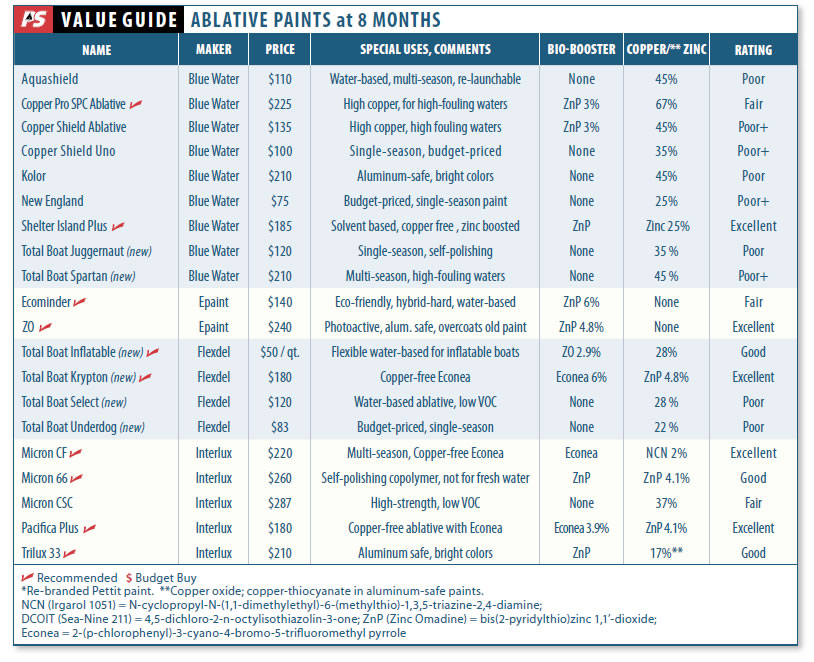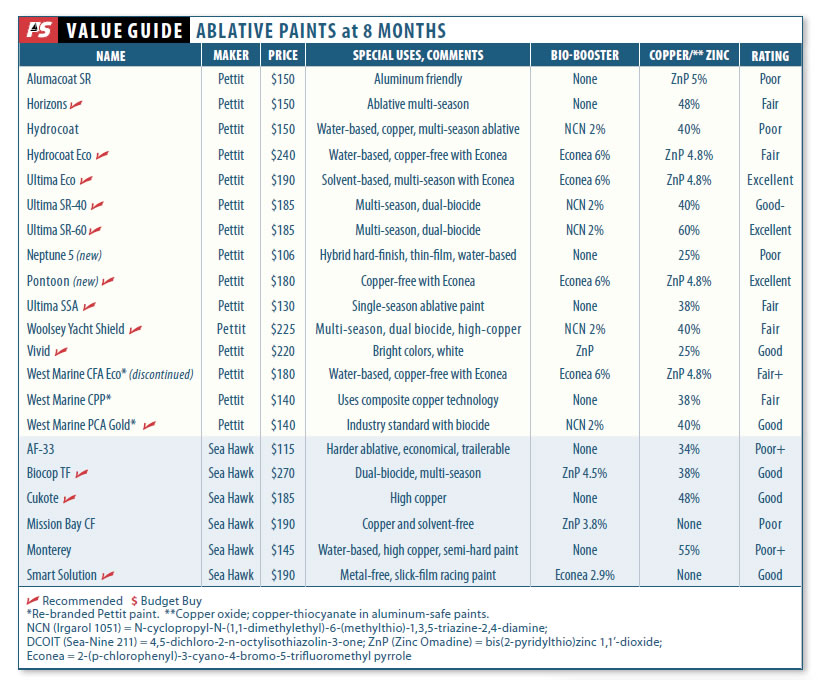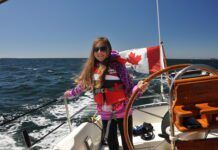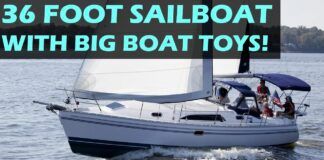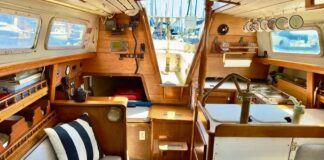A fairly significant change has taken place in the world of antifouling paint for recreational boaters in the United States. Last year, multi-national chemical company BASF decided it would not renew its U.S. license for the pesticide Irgarol. A common additive to copper-based paints, Irgarol helps prevent the growth of algae and other soft growth. Our tests have shown that although Irgarol doesn’t lengthen the duration of antifouling protection, it can noticeably help prevent slime growth during the first few months after immersion. As a result of BASFs decision, most manufacturers have a limited supply of Irgarol paints and have been phasing out products that contain it. Paints containing Irgarol are still on store shelves, but these inventories are expected to run out as early as this spring.
Bottom paints containing Irgarol are priced around $30 higher than similar formulas without the additive. If you are a seasonal sailor or a racer and you are drawn to a slime-resistant ablative paint, be sure to confirm that Irgarol is still an ingredient before plunking down the extra cash. Buyers will have to look at the active ingredients to determine whether a paint touted as slime resistant actually contains Irgarol 1051. As required by the U.S. Environmental Protection Agency, Irgarol 1051 is prominently listed in the active ingredients, usually under its systematic name, N-Cyclopropyl-N-(2-methyl-2-propanyl)-6-(methylsulfanyl)-1,3,5-triazine-2,4-diamine. It typically represents about 2 percent of the paint by volume.
Once the stock does run out, it wont be the end of the world. Many of the paints that once contained Irgarol now rely on added zinc to keep soft growth at bay, and based on our tests, this new approach works very well.
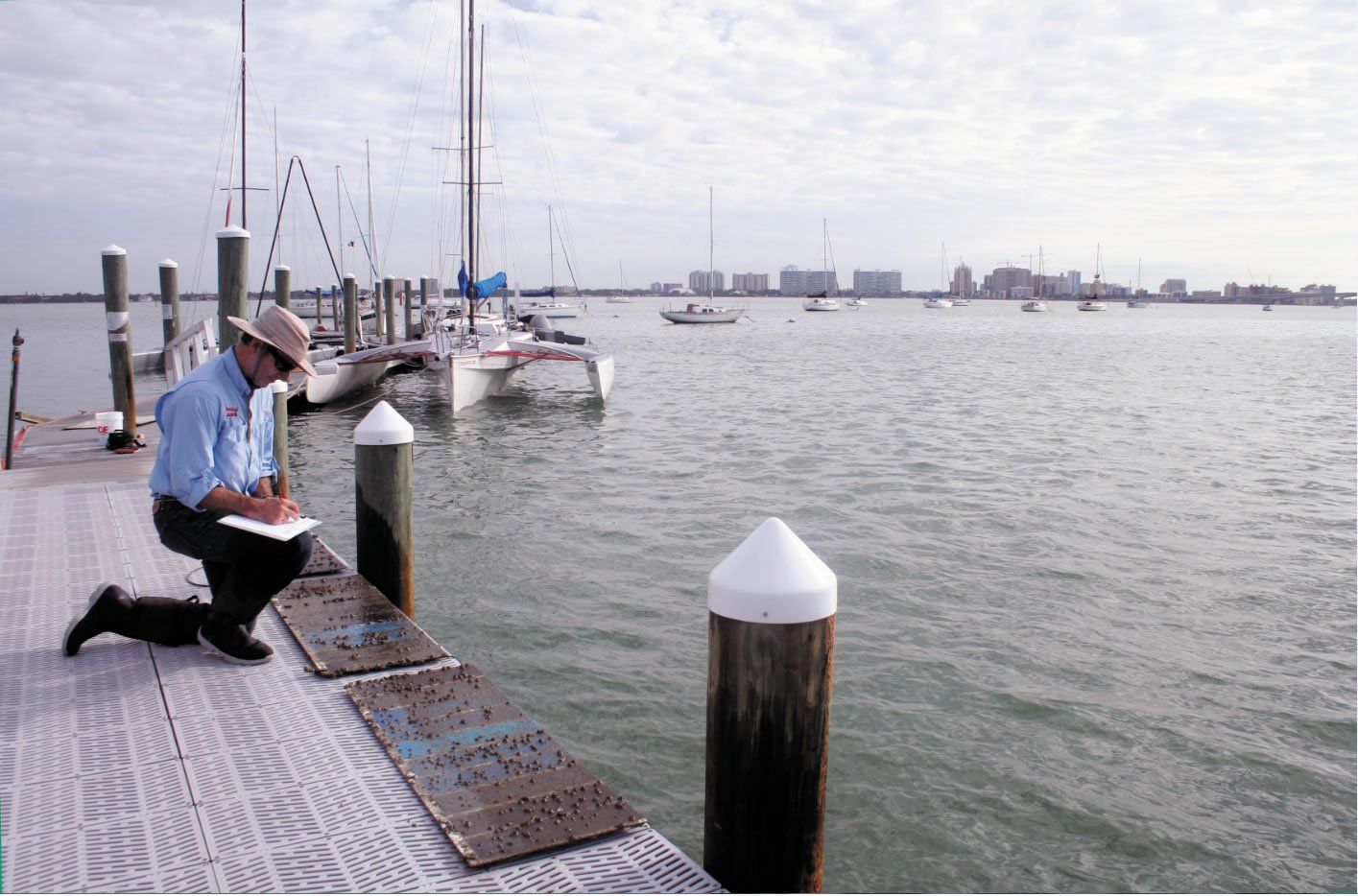
Choosing a Bottom Paint
Our advice for choosing a bottom paint remains the same as always:
Make sure the paint is compatible with your existing antifouling, or be prepared for whatever extra prep work might be required. Usually, all that is required is some light sanding and possibly a primer coat, although in some cases, more aggressive sanding and surface prep is required.
Make sure the paint matches your needs. Paints are formulated for specific conditions. We loosely classify bottom paints into two categories: hard paints and ablative paints. Hard paints hold up well to underwater cleaning and can usually be burnished smooth for racing. However, the layers that hard paints leave behind build up over time and eventually will need to be sanded off. Also, hard paints can require a light sanding before re-launch, or even lose their punch altogether if they are stored ashore for too long.
Most ablatives can be hauled and re-launched without worry. Ablative paints wear away, so they don’t build up paint layers over time. There are two main types-bottom-tier workboat ablatives that slough away to activate more biocide and more expensive copolymer ablatives that release biocides at a more controlled rate. Although ablatives are often called soft paints, some are relatively hard; these paints are sometimes referred to as hybrid paints and will usually resist light, underwater cleaning and are suitable for applying to trailered boats.
Hard and ablative paints are further divided into five broad sub-categories that often overlap: freshwater paints, aluminum paints, racing paints, water-based paints (easy for the do-it-yourselfer to apply), and eco-friendly paints. Paint types are indicated in the accompanying tables, and the best paints in each category earn Recommended ratings.
For the year-round sailor, long-lasting protection is a top concern. In past tests, weve broken down long-term performance by category and noted overall trends. Based on what weve found, the paints usually fail in this order, first to last, by type: freshwater paints; eco-friendly paints; low-copper, single-season paints; water-based paints; high-copper, multi-season ablative paints; and high-copper, multi-season hard paints. The much touted, quick-drying, dual-resin paints, introduced three years ago, have apparently lost favor and are not in the roster of most paint lines anymore.
With Irgarol out of the picture, zinc pyrithione is now the most common antifouling booster. Like Irgarol, zinc is most effective in the early months of immersion, and this test-panel checkup bore that out.
For more on selecting bottom paints, see the Inside Practical Sailor blog post Choosing a Bottom Paint for Dummies (posted Aug. 31, 2011 online).
What We Tested
For this test, we started with 68 different paints, but several are no longer available or never entered the retail market, so we are reporting on only 58 of them. Seventeen of the paints are classified as hard paints; the remaining 41 are ablatives. We focused primarily on North American brands, but many of these paints are also available in the Caribbean and South America, and a few can be found around the world (sometimes under different names). Last year, we looked at a smaller selection that had wide international distribution; see the October 2015 issue online for that report.
The manufacturers represented in this test include Blue Water Marine Paint, Epaint, Flexdel, Interlux, Pettit, and Sea Hawk Paint. Of the six, Interlux and Pettit control the largest share of the market.
With the exception of Epaint antifoulings, most of the paints from these makers are copper based. However, as more stringent environmental protections take hold, more copper-free paints are appearing. Today, one of the most commonly substitutes for copper is Econea, a non-metallic antifouling agent that has been used for years in other applications, but only recently was introduced to the North American recreational boating market. Our experience with Econea has been mixed. Although not as potent as copper over the longhaul, Econea clearly offers good to excellent protection for periods up to 12 months, occasionally longer. It will be interesting to see whether Econea will eventually draw scrutiny from regulators. In a world of ever-changing best management practices for harbors, no antifouling agent is guaranteed to be around forever. Here today, banned tomorrow might as well be the motto of the marine coatings industry.
Most of these paints are familiar as weve tested them many times before. Some are slightly modified blends from ones weve previously tested, and some products have nothing new except the name. Any of the test paints that are new in name or chemical composition are indicated as new in the accompanying Value Guide tables.
The static bottom-paint test panels were dropped in the water in June 2015 at the Sarasota Sailing Squadron in Sarasota, Fla. Results of their effectiveness after eight months of immersion are listed in the accompanying Value Guide tables. Given the often notable regional variations weve seen, we encourage boaters to also seek out recommendations from local boatyards and professionals to cross-check with this report.
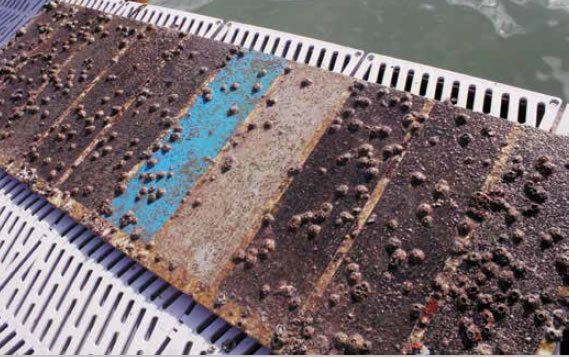
How We Tested
Each test paint was applied to a section of 6-foot by 2-foot fiberglass panels for testing. Testers followed the makers instructions for preparation and application. There were no more than 10 samples per test panel. Prior to rating the paints on each panel, testers sluiced the panel with a bucket of salt water.
Paints were rated Excellent (no growth), Good (light soft growth), Fair (moderate to heavy soft growth), and Poor (hard growth). Any paint rated Fair is considered to still be active. This was a particularly tough year for many paints, with a much higher failure rate than previous tests.
A Recommended paint is one that performed best overall or rated best among its specialty peers (best aluminum-safe paint, best water-based paint, best racing paint, etc.). The Budget Buy paints are the least costly among the Recommended paints. All prices were double-checked online at the time of publication, but these can vary by vendor.
Any antifouling test is subject to a number of variables. How and where you use your boat, as well as the maintenance regimen, can affect a bottom paints longevity and performance. We suggest supplementing our data with local knowledge from independent sources.
It is very important for the year-round sailor to keep in mind that just eight months have passed in this test. Although the copper-free paints are doing well, these formulas have rarely shown the longevity of the top-shelf copper blends.
Blue Water
We tested 13 paints from New Jersey-based Blue Water Paint. The group included two hard paints; the rest were ablatives. The best Blue Water paint in the hard group was Copper Pro SPC, which has a high copper content (up to 67 percent by weight). This paint replaced Copper Pro SCX 67, which contained Irgarol. Among the Blue Water ablatives, the copper-free, zinc-boosted Shelter Island Plus was the cleanest.
Blue Water also produces three paints sold under the Total Boat brand, which was introduced recently by online marine retailer Jamestown Distributors; paint maker Flexdel manufactures the remainder of the Total Boat paints. We tested two of the Blue Water-made Total Boat paints; the best of the two was the Total Boat Spartan, which contains 45-percent copper by volume.
Blue Water paints are available through the companys website or through distributor Donovan Marine (www.donovanmarine.com). Some of the paints are also sold under the MarPro label.
Epaint
Epaint is the master of photo-active, copper-free blends that release a biocide when exposed to light. It also has two release coatings that rely heavily on their slick surface to shed barnacles. The photo-active blends have consistently done well in previous PS tests, and in this checkup, all were extremely clean, with virtually no slime.
The only dim spot in the Epaint lineup was the water-based Ecominder, a paint aimed primarily at the fresh water or seasonal sailor. Northern-latitude sailors should keep in mind that several Epaint coatings are activated by sunlight, so sailors in less sunny environments are unlikely to get the same results that we do on our test panels.
Flexdel
More familiar to boatbuilders and commercial marine enterprises, Flexdel paints have been absent from our tests for a few years. They reappear here under Jamestown Distributors Total Boat brand. As it was with other makers, the top finisher in the Total Boat group was the Econea paint, Krypton. Right behind it was Total Boats flexible paint for inflatable boats.
Interlux
Two copper-free paints from Interlux, Micron CF and Pacifica Plus, were barnacle free and showed very little slime after eight months. The two have the same percentage of active ingredients (zinc and Econea), but they have slightly different binding agents that control the rate at which the biocide is released. Costing about $40 more per gallon, Micron CF should last longer, but the seasonal boater will be just as well protected through the summer with the cheaper Pacifica Plus.
Regularly a top contender, Micron 66 was nearly clean as these Econea-based paints. Historically, Micron 66 has easily outlasted the copper-free paints. Missing from this round was high-potency ACT, one of Interluxs most popular paints and a standout at 12 months in our last bottom-paint review; we stand by our recommendation for that paint for the seasonal boater.
Among Interluxs hard paints, the water-based Fiberglass Bottomkote Aqua was still fighting barnacles at eight months; its a good choice for do-it-yourselfers who prefer hard paints.
Petit/West Marine/Woosley
Until recently, Pettit (a Kop-Coat Marine Group brand), which also makes a line of paints for West Marine, added Irgarol to four of the paints we tested, all of them ablative. Unless you pick up some of the older stock with Irgarol still in it, the blend you buy-though it will bear the same name-will be a different formula. If the past is any guide, the drop in protection against growth will only be noticeable during the first few months. Again, the Econea paints fared best in this group, with only the water-based Hydrocoat Eco falling below Excellent. (The water-based Econea blends fell short of their solvent-based brothers in previous tests as well.)
Among the copper-based ablatives, Ultima-SR60 was the best. Not far behind was Ultima-SR40, a multi-season paint with slightly less copper. West Marines PCA Gold also fared well in this category. All three contained Irgarol, so unless you uncover some older Irgarol-boosted paint, you may see performance lag behind ours. Among copper-based hard paints, Trinidad and Trinidad SR were among the cleanest in our test.
Sea Hawk
Florida-based Sea Hawk Paint features a few copper-free paints and one that contains no metal at all, Smart Solution. Along with Biocop TF and Cukote (both of which have fared well in previous long-term tests), the newly reformulated Smart Solution was holding its own at eight months.
Conclusion
These results can be misleading for the year-round sailor, since we expect many of the Econea paints to start failing after about 12 months, while some of the higher copper-based paints will continue to maintain potency. For this reason, we have no Best Choice ratings in this round. If you are a seasonal sailor, a zinc-boosted, Econea-based paint is a good bet. Racers and seasonal sailors also should look at Epaints top blends; these were noticeably cleaner than their peers. Keep in mind that some Epaints are not compatible with other paints, so application would include stripping the old paint and priming the hull.
For year-round sailors, Micron 66 (ablative) and Trinidad (hard) are preferred, along with the high-copper ablatives from Sea Hawk and Blue Water. For those who want to spend as little as possible, Woolsey Defense offers high-copper content at a low price. If you are painting every year, an ablative makes better sense, to avoid paint buildup. Unfortunately, none of the budget-priced ablatives did very well. West Marines CPP ($150) was the best of the bunch, but Interlux ACT is also an option-as it has done well in previous years.
Anyone who is interested in long-term protection should also look at our March 2014 bottom paint report online; it highlights U.S. regional preferences and lists paints that have consistently done well at the 24-month mark.
As always, we appreciate hearing from sailors about their bottom-paint experiences. Send reports to [email protected]; please put bottom paint report in the subject line.

